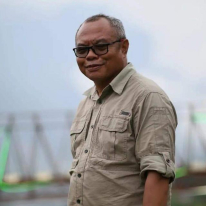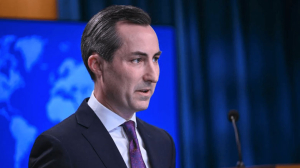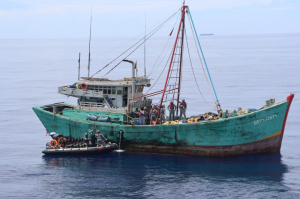Nickel downstreaming impoverishes people, damages environment: Trend Asia
Nickel downstreaming, which is relied on and revered by the government as a surefire move, potentially damages the environment and impoverish the poor amid the intertwining natural resources, a study by Trend Asia reveals.
Firman Imaduddin, Communication Team of Trend Asia, says there are several bad facts about nickel downstream in North Maluku, a focus of its study. First, the nickel downstream industry in North Maluku apparently does not provide economic benefits to local residents, especially residents who live around the downstream areas. Instead, there are residents who lose their sources of economic production such as agricultural land, gardens and fishing areas, on the contrary to those who are not local residents but enjoy the benefits of nickel downstream in North Maluku.
Nickel processing industry in North Maluku is the fruit of the downstream policy that has been promoted by the government since 2015 and is claimed to have succeeded in boosting the economy of North Maluku, with 23.89 percent growth recorded on the second quarter of 2023. North Maluku then boasted the status of a region with the highest economic growth in all Indonesian provinces, even far exceeding the national economic growth.
"But strangely, this economic growth is not in line with the poverty rate, which is still relatively high. Based on data from the North Maluku statistical data, the poor population in March 2022 was recorded at 79.87 thousand people, which rose to 82.13 thousand in September 2022, and to 83.80 thousand in March 2023," said Firman in a release related to results of joint research published on Wednesday, January 31, 2024.
The word "downstreaming" emerged in the fourth debate session for the 2024 presidential election on January 21, 2024. Vice Presidential candidate Gibran Rakabuming Raka, a running mate for Presidential Candidate Prabowo Subianto in the upcoming presidential election, uttered the word downstream 12 times in an attempt to explain his and Prabowo’s program and energy transition push.
It was not only Prabowo-Gibran, however, that promotes the issue as the other two pairs − Anies Baswedan-Muhaimin Iskandar and Ganjar Pranowo-Mahfud MD also concurred. Downstreaming is a program by President Joko Widodo, regulated through Law No. 3/2020 on the Amendment to Law Number 4/2009 concerning Mineral and Coal Mining, which requires the mining industry to carry out downstreaming, a project none other than to provide added value for mining products.
In reality, however, nickel downstreaming in North Maluku is heartbreaking. There are three downstream nickel ore processing industries in North Maluku. Of the three, two are already in operation, namely Harita Nickel on Obi Island, South Halmahera and PT Indonesia Weda Bay Industrial Park (IWIP), which is integrated with PT Weda Bay Nickel, in Weda, Central Halmahera. Meanwhile in Buli, East Halmahera, there is a plan to build an electric battery vehicle component factory initiated by a consortium of LG and a consortium of state owned enterprises, IBC.
The three areas have been as National Strategic Projects (PSN). In addition, privileges were again given by the government to the three areas as they are designated as National Vital Object, making them heavily guarded by military and police officers.
Secondly, nickel mining activities in North Maluku have created great environmental damage, not only on land, but also coastal and marine areas. There were two environmental events in November-December 2023that were considerably associated with the nickel downstreaming policy, namely changes in the color of sea water on the coast of Garaga Island, Obi Islands, South Halmahera and the coastal and sea water in Maba District, East Halmahera.
Changes in sea water color to reddish brown in both locations are suspected to be caused by the nickel industry. Halmahera, the largest island in the Maluku archipelago, has been a raceground for mining companies for the past two decades, whose increasing dredging activities are feared to devastate Island.
Nickel ore mining is also not only taking place in Halmahera, but also targeting small islands such as Gee Island, Pakal Island, Gebe Island, and Mabuli Island. Mabuli Island is part of the chain of Obi Islands that have been devastated.
"The exploitation of nature in small islands is considerably an act of environmental crime as these islands are vulnerable to ecological destruction along with the increasing mining activities. Mining activities also have the potential to trigger social conflict among residents,” Firman said.
Third, nickel downstreaming directly results in uncontrolled deforestation by nickel ore mining companies. Nickel ore mining is preceded by land clearing activities, therefore it potentially triggers loss of forest cover, especially in the three locations that are now surrounded by nickel Mining Business Licenses (IUP).
There are 19 licenses with a total concession area of 101,047.21 hectares in East Halmahera, while in Central Halmahera there are 13 licenses with a total concession area of 10,390 hectares.
Meanwhile in South Halmahera, there are 15 licenses with a total concession area of 32,236 hectares. For nickel mining business permits that annexed two administrative areas at East Halmahera and Central Halmahera, there are 4 licenses with a total concession area of 70,287 hectares.
Thus, forest cover loss has predominantly occurred in nickel ore mining operational areas. Global Forest Watch spatial analysis data shows that from 2001 to 2022, Central Halmahera has lost 26.1 thousand hectares of tree cover, which is equivalent to a 12-percent decrease in tree cover since 2000, and equivalent to a 12-percent decrease in forest cover since 2022, or an equivalent to 20.9 Megatons (Mt) of carbon dioxide equivalent emissions (CO2e).
Meanwhile, East Halmahera has lost 56.3 thousand hectares of tree cover from 2001- to 2022, an equivalent to an 8.9-percent decrease in tree cover since 2000, or an equivalent to 44.5 Megatons (Mt) of carbon dioxide equivalent emissions (CO2e). While South Halmahera has lost 79.0 thousand hectares of tree cover from 2001 to 2022, which is equivalent to a 9.9 percent decrease in tree cover since 2000, or an equivalent to 62.9 Megaton (Mt) of carbon dioxide equivalent emissions (CO2e).
Fourth, results of research by WALHI North Maluku chapter from March to April 2023, entitled "Status of Water Quality and Health of Marine Biota in the Waters of Weda Bay and Obi Island" concluded that the are indications of water pollution in the Weda Bay and Obi Island areas, with the level of pollution having impacted the marine biota, such as clams and fish. Fish targeted for consumption have been exposed to heavy metals, which are toxic and harmful to the surrounding community. The same condition also occurs in the waters of Buli Bay, East Halmahera.
"The water pollution were identified in three locations which are close to nickel downstream industrial areas, such as Harita Nickel, PT IWIP and PT Aneka Tambang (ANT) nickel mining operational areas," Firman said.
Fifth, nickel downstreaming also directly destroys rivers such as the Akejira and Ake Kobe Rivers that run through the settlements in Central Weda villages of Woekop, Worjerana, Kulo Jaya, and Lukulamo in Central Halmahera, where the river water turns reddish brown, indicating that the water is contaminated with soil.
The contamination of water with nickel mining ore has made residents losing' access to the two rivers. Originally, the river was a source of clean water for household needs of local residents. However, nickel mining operations such as by PT Weda Bay Nickel (WBN) ,which is located in the upstream of the river is strongly suspected of having contaminated the river water.
Apart from PT WBN, PT Tekindo Energi is also suspected of contributing to the changes in color of the river water. Besides the two rivers above, the Sageyan River in Sagea Village, Weda district, Central Halmahera also suffered a similar fate.
The river, an ecotourism object as well as a source of drinking water for residents in Sagea village which is connected to the karst region, also often shows a change in water color to reddish brown even when it is not raining. The change in Sageyen's water color is suspected to be caused by PT WBN's mining operations in the upstream area.
The study also found that destruction of rivers associated withdownstream also occurred in Sangaji River, Maba, East Halmahera and Toduku River in Obi, South Halmahera.
Sixth, the impact of nickel downstreaming by Harita Nickel has also expelled residents in Kawasi Village, Obi District South Halmahera from their original village. Harita Nickel has built a new residential area that they call the Kawasi ecovillage. But this new area is built on plots of land belonging to residents, who had been evicted even though they refused to move. What was done by Harita is nothing less than depriving Kawasi villagers of their living space.
Seventh, the nickel industry downstream area, which is included in the government’s "green economy" agenda as a solution to the climate crisis, is still dependent on the operation of coal-fired power plants in the Harita Nickel Industrial area in Obi and PT IWIP in Weda, which continuously spray combustion emissions into the air that worsens air quality and causes respiratory illnesses. At PT IWIP, for example, the existing capacity of the coal-fired power plant is currently 6,560 MW with a planned additional capacity of 760 MW, bringing the total development to 7,320 MW. On the other hand, cases of respiratory problem around the area were recorded to increase. Data shows that in 2020 there were 434 cases of Acute Respiratory Infectios in Lelilef, while in 2022 it rose to 1,100 cases.
Eighth, the deployment of state security apparatuses at National Vital Objects is considered repressive, especially the police officers’ use of excessive forse in response to residents’ rejection against the National Vital Objects in Halmahera, North Maluku.
Repressive actions against the protest by the public are a real portrait of violation to citizens' constitutional rights, where the state should be present to provide protection to its citizens, not the other way around.
"The actions taken clearly violate internal police regulations, one of which is the National Police Chief Regulation No. 7/2012, which requires members of the National Police to act professionally and uphold the rights of the citizens. In practice, the Police must also avoid violence, persecution, harassment, and other violations of human rights," Firman said.
Tag
Already have an account? Sign In
-
Start reading
Freemium
-
Monthly Subscription
30% OFF$26.03
$37.19/MonthCancel anytime
This offer is open to all new subscribers!
Subscribe now -
Yearly Subscription
33% OFF$228.13
$340.5/YearCancel anytime
This offer is open to all new subscribers!
Subscribe now






